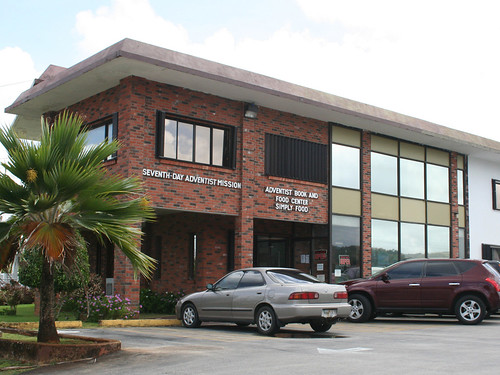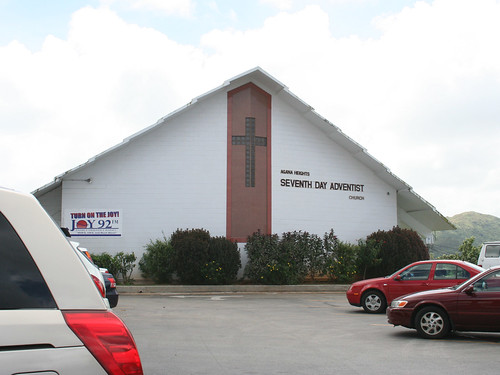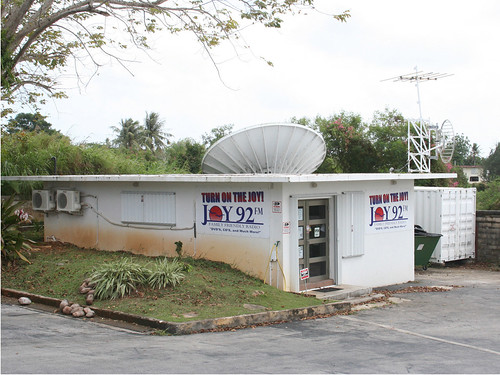History on Guam
During World War II, two American servicemen by the names of Henry Metzker and Bob Beckett played key roles in the origins of the Seventh-day Adventist Church on Guam.
Beckett, a nurse in the 204th Army General Hospital in Hawai’i, was one of seven Adventists bound for Guam during the war. Before leaving Hawai’i, Beckett’s pastor approached him about establishing a church on Guam, a place where they had not had much success in the past.
Upon landing on Guam in 1945, Beckett’s military outfit pitched tents to function as a hospital for war casualties. On the first Saturday of their arrival, a small group of Adventists came together to worship, and thus held the first Seventh-day Adventist service on Guam. The following week, attendance grew as more men from the 373rd Station hospital joined them. Before long, one sailor, Henry Metzker, asked if he could bring Chamorros to the worship service. Beckett embraced the idea and immediately visualized the establishment of a permanent church with Chamorros included in the congregation.
Metzker first encountered islanders interested in the Seventh-day Adventist church after scouring the villages in search of a church. Although he did not find a Seventh-day Adventist church, he did come across a local family who expressed interest in the church that kept Sabbath on Saturday. That family included Maria A. Ulloa. Because she knew nothing about the Seventh-day Adventist Church, Ulloa agreed to listen to Metzker give a Bible lesson. In time, Metzker made several more visits to the family to provide further teachings about the church.
Shortly thereafter, the Ulloa home served as a place of worship for Seventh-day Adventists. Following more Bible study, members of the Ulloa family became adequately informed about the doctrines of the Seventh-day Adventist church and a formal request for their baptism was made. The Far Eastern Division office of the Seventh-day Adventist Church located in Singapore responded to the request and arranged for someone to go to Guam to perform the ceremony. However, because the military maintained Guam as a restricted area and entry into the island required naval security clearance, the church realized it would be difficult to send someone soon since the church had no formal presence on the island.
Events which took place in 1945 would however prove fortuitous for the fledgling church. The Far Eastern Division planned to send two missionaries who had been hired by the U.S. government to serve as translators in Japan. While en route to Japan for their new job, the two men, Andrew Nelson and F.R. Millard, arranged to stop on Guam to perform the baptism. As news of a storm came, their departure to Japan was delayed, thus giving the men the extra time needed to perform nine baptisms of members of the Ulloa family in Tumon Bay. In October 1945, the Ulloa family became the first members of the Remnant Church of Guam.
The believers were left on their own for two years until the arrival of Filipino Pastor Jose O. Bautista, who arrived on September 5, 1947 from Palau where he was doing work. By December 25, 1947, another baptism of six believers from the Miguel Taitano family took place. On May 21, 1948, Pastor Robert E. Dunton arrived from California. The Far Eastern Division later sent V.T. Armstrong and C.P. Sorensen to help establish the Guam mission.
The church on Guam was organized on May 29, 1948, just after Pastor Dunton’s second Sabbath on Guam. Members continued to meet in the makeshift chapel attached to the Ulloa home in Dededo. This would ultimately be the location of the first Dededo church.
Another milestone took place on March 23, 1950. This date marked the first session and the beginning of the Guam-Micronesia Mission, an organization that supports Christian education and Adventist churches in eleven islands of Micronesia. The islands include Chuuk, Ebeye, Guam, Kosrae, Majuro, Pohnpei, Saipan, Rota, Tinian, Yap and Palau.
Also in 1950, the second and third churches began in Talo’fo’fo and Inalåhan, respectively. Four years later, the Inalåhan church would fold into the Talo’fo’fo church, and on 11 June 1960, the Agana Heights Seventh-day Adventist Church opened. The Agana Heights chapel was dedicated to Mrs. Ana T. Gay, an early convert who donated the property for erecting a church for the Guam-Micronesia Mission.
A fourth church was organized in Hågat on 17 November 1963. The Yigo church was organized in 1987, beginning with several families who had come from the Dededo and Agana Heights church. A Micronesian church was also organized in 1987 under the guidance of Pastor Willy Nobuo, who arrived on Guam from Palau in 1986. A Korean church began in the summer of 1987, with Hugh Kim as lay leader of the group.
Education
Even before the Guam-Micronesia Mission was officially recognized, fervent believers began a school for Christian education. Maria Ulloa and Magdalena Taitano Flores, both public school educators, took leave from their work to start a Seventh-day Adventist school on Guam. Starting in 1949, the women taught Christian education in the first school located in Dededo. A Talo’fo’fo school would soon follow. In 1954, the Agana Heights mission became the home of the Far Eastern Island Mission Academy, where it remained for seven years.
Eventually, both the Dededo and the Talo’fo’fo school merged with the Agana Heights school. Later, the school relocated to its current location in Windward Hills. The Guam Adventist Academy was dedicated in 1964, after a complete reconstruction following Typhoon Karen in 1962.
Church beliefs
Seventh-day Adventists are Bible-believing Christians who base their faith, hope and future in Jesus Christ as their only hope of salvation. According to Eph. 2:8, 9, they believe that they are saved by grace alone and not by works. While the Seventh-day Adventist Church shares most doctrines in common with mainstream Christianity, there are some biblical doctrines that set it apart from other denominations.
The Church believes that the biblical Sabbath is Saturday the seventh day of the week, a special day set aside to honor and worship God. Each Saturday, Adventists enjoy a 24-hour Sabbath rest which begins at sunset on Friday and ends at sunset on Saturday. The Sabbath offers an opportunity to rest from social or secular activities, like work and school or anything that is not of a spiritual nature. Seventh-day Adventist cherish this time together to join family and fellow believers in worship, fellowship, service, prayer and communion with God. As “Adventists,” they believe in the imminent or soon return of Jesus Christ in the clouds of heaven. They look forward to this special event, the blessed hope, at which time the dead in Christ shall rise from the grave.
Adventists believe that God bestows spiritual gifts upon members of the church to fulfill divinely ordained functions. Such gifts include ministries of faith, healing, prophecy, proclamation of the everlasting gospel, teaching and self-sacrificing service and brotherly love one for another. Furthermore, Adventists are called to live in accordance with the moral law, the Ten Commandments, which is a transcript of the Lord’s character. They are encouraged to develop and maintain a personal and daily relationship with Christ. This personal relationship enables them to pursue a life of Christian purity, appreciation and acceptance of others, and community involvement. Because the body is the temple of the Holy Spirit, Adventists care for their bodies through exercise, rest and a healthful diet.
Around the world and throughout the island of Guam and Micronesia, Adventists have developed a sound reputation as a people who believe that the bible is the inspired word of God and is the standard of character, the test of experience, the authoritative revealer of doctrines, and the trustworthy record of God’s acts in history.
Adventists have also developed a sound reputation for their emphasis on healthy living practices and education. The Seventh-day Adventist Church operates nearly 6,000 parochial schools around the world, including the Guam Adventist Academy in Windword Hills, Yona and every main island throughout Micronesia. The Church also operates clinics, hospitals, medical institutions, universities, such as Loma Linda University in Southern California, renowned for its pioneering work in cancer research and heart transplants. It also operates a global broadcast system of radio, television, internet, satellites and other electronic and print media.
Services and programs
Seven churches throughout the island provide health and community services for the residents of Guam.
Agana Heights Seventh-day Adventist Church
Located at 290 Chalan Palasyo, Agana Heights (across from the governor’s house)
Pastor: Taigo Cunha
Hågat-Sånta Rita-Sumai Seventh-day Adventist Church
Located on Salinas Road
Pastor: Rylan Kuartei
Happy Family Seventh-day Adventist Company
Located off Route 3 NCS (across Guam Regional Medical City hospital)
Paster: Luis Mafnas
Korean Seventh-day Adventist Church
Located on Iglesias Circle in Dededo (across from Santa Barbara Catholic Church)
Pastor: Koo Hyung Jung
Man’Aguiya Fellowship
Located in Lower Barrigada Heights’ Bo-ing Mart Building Plaza
Pastor: Rylan Kuartei
Northern Seventh-day Adventist Church
Located off of Marine Corps Drive at 223 Wusstig Road
Pastor: Luis Mafnas
Ypao/Ordot Seventh-day Adventist Church
Located on Tun Bihue Road in Ordot (near Agueda Johnston Middle School)
Pastor: Mesikt Idechong
Talo’fo’fo Seventh-day Adventist Church
Located in Talo’fo’fo between Notre Dame High School and the four-way intersection in the village center
Pastor: Remenster Jano
The Seventh-day Adventist mission also includes the Guam SDA Clinic in Tamuning, as well as the Adventist World Radio and JOY 92FM. Additionally, the Church operates a vegetarian restaurant and health food store, Simply Food, which is located in Agana Heights.
Medical clinic
The Seventh-day Adventist Clinic on Guam began operations with one physician in a tin-roof structure in Agana Heights in 1956. Today, the SDA Clinic is a multi-specialty facility located in Tamuning with a staff of over twenty healthcare professionals.
The first medical missionaries, Dr. and Mrs. Raymond Barker, arrived on the island in 1953. Dr. Barker first worked at Guam Memorial Hospital until the construction of the clinic was completed. Dr. Leslie Smart joined Dr. Barker in 1956 to help launch the medical facility. The clinic became fully operational with the arrival of a nurse by the name of Violet Clark (Cruz) a year later.
In 1966, the clinic relocated to its present site on Ypao Road in Tamuning.
For further reading
Guam Seventh-day Adventists. “Guam Churches Divine Service & Directions.” 7 February 2020.
Guam Seventh-day Adventist Clinic. “Homepage.” 6 July 2021.
Nobuo, Willy S. “Guam-Micronesia Mission: Jewels of the Pacific.” Isles (Third Quarter, 1988).
Seventh-day Adventist World Church Official Website. “Adventist.org.” 6 July 2021.



